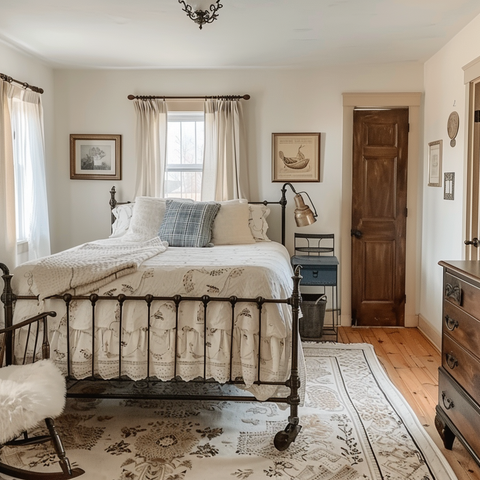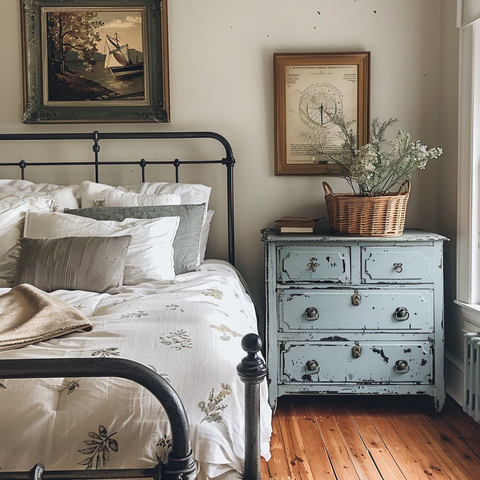Free Shipping on Orders $99+
Menu
-
-
Decor
-
Bed & Bath
-
Furniture & Lighting
-
Rugs
-
Tabletop
-
Storage
-
Walls
-
Gifts
-
Outdoor
-
Seasonal
- Sale
-
- (631) 572-3140
- Login

Free Shipping on Orders $99+

Where Is The Best Place To Put A Bed In A Bedroom
January 26, 2022 4 min read
In most bedrooms, the bed is the biggest and most important piece of furniture. It's also one of the hardest pieces of furniture to place. Where you put your bed says a lot about the room and also dictates how useful the rest of the space is.
Everyone’s bedroom is a little different, and so is everyone’s ideal bed placement.
Don’t worry if you’re stressed about your bed placement. We’ll talk about the different options, what they mean for the rest of your room, and how you can decide what placement option will work best for you.
Ready to get started?
Bed Placement Ideas

The main thing when it comes to placing your bed is finding a placement that works for you and your room. Remember that you can always rearrange later, but that it's usually more difficult to rearrange than to find a good placement from the start.
Let’s take a closer look at common bed placement, and what your options are.
Centered Beds

Centered beds are just about the most common placement, and there’s a reason this room design is so popular. Usually, a centered bed is placed right in the middle of the longest wall of the room, with the headboard against the wall and the foot of the bed closest to the bedroom door.
This kind of placement is common partly because it makes the bed the focal point in the room. That makes it easier to make your bedroom a place where you focus on sleep, but it also means that the rest of the room is probably a little less functional.
Another big advantage of centered beds is that they let you have bedside tables on both sides of the bed. That’s great if you’re sharing your bed with a partner since it means you can both have alarm clocks, phone chargers, drinks, and other conveniences nearby when you’re in bed.
Centered beds also give you the option of having a reading lamp or other conveniences.
However, since your bed is usually the biggest piece of furniture in your room, centered beds aren’t always the most practical choice. You should make sure you at least have room to walk around your bed if you have a centered placement, and will probably need room for a dresser at least.
Corner Bed

Corner beds are where you put the bed in the corner of the room, usually with the headboard and one side of the bed against the wall.
In some rooms, though, you can put the bed in at an angle in the corner so that both sides are accessible. The downside of this placement is that you lose the space between the headboard and the corner.
Corner placements are usually a good option in smaller rooms, anywhere there isn’t enough space for a bed, dresser, and any other furniture you need to fit comfortably in the bedroom.
Putting your bed at an angle against the corner is a bolder statement than having one side against the wall. This arrangement is closer to having a centered bed, but doesn’t make the best use of space and usually doesn’t allow for bedside tables.
But, putting your bed in the corner can help you take advantage of built-in features like wardrobes, radiators, fireplaces, and large windows.
Under The Window
Putting your bed under the window is another common option, but one that’s also a little more controversial than most other options.
There are a few reasons putting your bed under the window can be a good thing. For one thing, it might look good in your room, especially if the bed is across from a fireplace when you put it under the window.
In some bedrooms, putting your bed under the window might also be one of the only good placement options.
However, putting your bed under the window also means that you might have to deal with nighttime drafts from the window. It may block the view, especially if you keep curtains closed, and it probably means that you’ll wake up when the sun comes up. The sun can be a particular problem if you’re a light sleeper or work the night shift.
Bed Opposite A Door
This position is one of the least popular for a few reasons. For one thing, some people don’t feel very secure if they’re sleeping too close to a door.
Feng Shui also agrees with people who don’t like sleeping near the door. Specifically, in Feng Shui placing your bed in line with the door invites bad energy into your room. But, putting your bed diagonally away from your door is fine.
Ideally, you should be able to see your door from your bed, but not be in direct line with it.
Bed Island
The bed island, where your bed is in the middle of the room and doesn't touch any walls, might be a controversial choice, but it makes sense in some rooms.
This placement takes up a lot of room, so it usually works best in large rooms where there’s plenty of space to go around.
Beds in the middle of the room can also feel loose and unfinished but adding a rug can often help them feel a little more grounded.
But, putting your bed in this position can make it a lot easier to get in and out of bed, and it’s a lot easier to make the bed as well.

Don’t Place Your Bed Here
There are a few different places that aren’t a good position for your bed.
For instance, you don’t want to put your bed on a shared wall with the bathroom. You will hear bathroom noise if you put your bed here, and it can make it hard to relax.
You should also avoid any walls that are known to have noisy pipes. It’s actually a good idea to use an air mattress or similar to sleep in your bedroom for a couple of nights so you can figure out where the pipes are and avoid them.
It’s also important to make sure your chosen bed position makes sense in the room. Don’t choose an island bed in a room that’s too small to hold one, for instance. Or a centered bed if that means you can’t use the rest of the space.
Making your bed placement make sense with the rest of your room is critical.
Leave a comment
Comments will be approved before showing up.
Newsletter
Sign up to get the latest on sales, new products and more …
and receive 10% off your first order!

Receive 10% Off Your First Purchase!
Sign up to receive the latest on new products and promotions!
